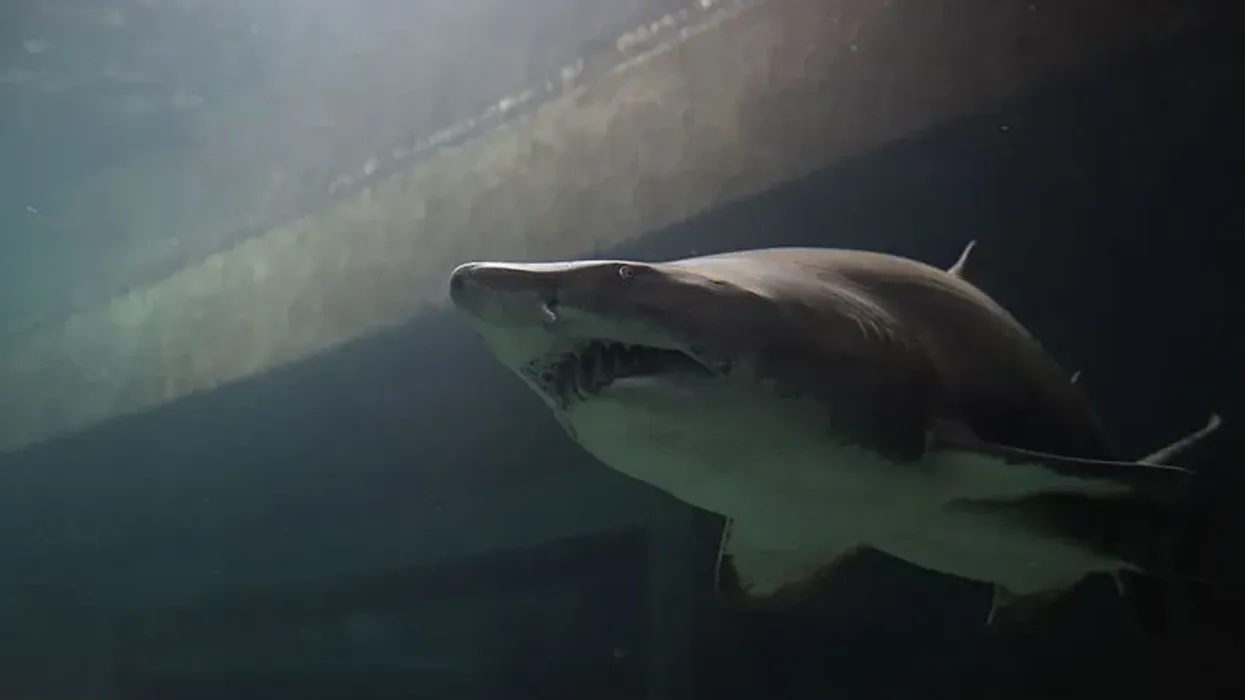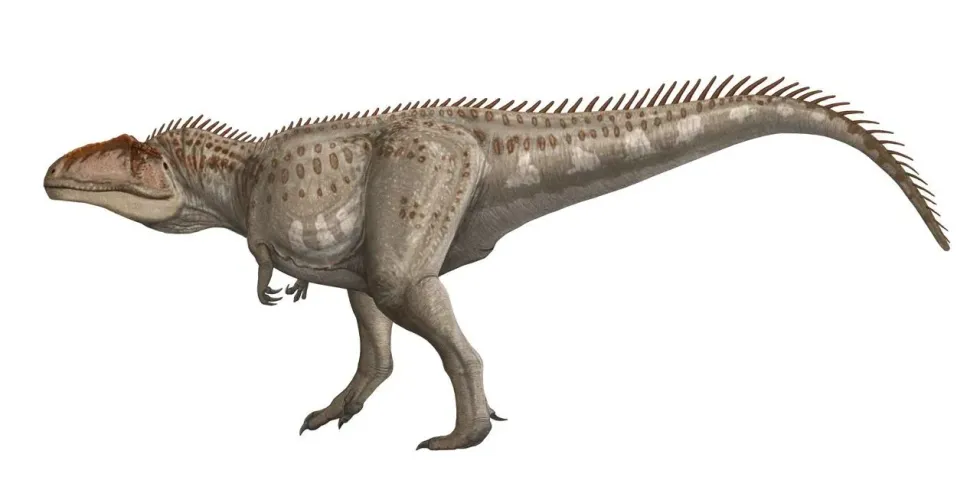The bigeye sand tiger shark (Odontaspis noronhai, Maul, 1955) is an extremely rare species of shark that habitats the extreme depths of the ocean. The depth range from 200–3280 ft (60–1000 m).
They have been discovered in the Indian Ocean, the Pacific Ocean, the Atlantic Ocean, and in southern Brazil. Due to their utmost rarity, the exact world population of these sharks is not known.
This shark has a broad, bulbous, conical shape, with sharp rows of teeth protruding out even when the mouth is closed.
No such incidents of these sharks have been recorded of attacking humans unless they have been provoked. To know more facts about nictitating membranes, embryos, yolk sac, teeth, length, snout, pectoral fins, the IUCN Red List status of the basking bigeye sand tiger as well as other facts regarding these sand tiger sharks, continue reading this article.
If you like this article, you can also read our articles on rockfish and rainbow trout.
Bigeye Sand Tiger Interesting Facts
What type of animal is a bigeye sand tiger?
The bigeye sand tiger shark (Odontaspis noronhai) that has a long snout is an extremely rare species of shark that is usually found in the depths of the Indian Ocean, the Pacific Ocean, and the Atlantic Ocean.
What class of animal does a bigeye sand tiger belong to?
The bigeye sand tiger (Odontaspis noronhai) found in the deep Indian Ocean, the Pacific Ocean, and the Atlantic Ocean belongs to the Chondrichthyes class and Odontaspididae family of the Animalia kingdom.
How many bigeye sand tigers are there in the world?
As these sand tiger species are extremely rare, no definite data is available regarding the total population of individuals around the world or in their distribution range. They are Not Evaluated by IUCN Red List.
Where does a bigeye sand tiger live?
The bigeye sand tiger shark's most common continental distribution is in the ocean's extreme depths worldwide, mainly the Pacific Ocean, the Atlantic Ocean, or the Indian Ocean. However, recently their range has been found at considerable depths off the coast of southern Brazil.
What is a bigeye sand tiger's habitat?
The bigeye sand tiger that has a long snout lives in the range of extreme depth of the oceans. The depth range is from 200–3280 ft (60–1000 m). In general, sandy coastal waters, shallow bays, estuaries, and rocky or tropical reefs habitat are where sand tiger sharks are usually found.
Who do bigeye sand tigers live with?
The bigeye sand tiger species are considered to be solitary creatures, lurking all alone in the extreme depths of the oceans. Not much data is available to accurately determine this due to the rarity of these creatures.
How long does a bigeye sand tiger live?
The bigeye sand tiger shark (Odontaspis noronhai) has an average lifespan of 15-40 years.
How do they reproduce?
Little is known about the reproduction of bigeye sand tigers due to their scarcity, but ecologists assume it is similar to that of other mackerel sharks. They are considered to be viviparous.
They lay a cluster of eggs, though the exact number is still unknown. Adult females possess two functional uteruses and one single functional ovary on the right.
The male pups mature sexually upon reaching the length of 7.2-10.5 ft (2.2-3.2 m) and female pups mature at around the length of 10 ft (3.2 m). Sand tiger sharks, in general, mate through a process of internal fertilization.
What is their conservation status?
The bigeye sand tiger shark with a long snout found in the deep Indian Ocean, the Pacific Ocean, and the Atlantic Ocean is an extremely rare range shark species. Due to their rarity, not much is known about these sharks. They are Not Evaluated in the IUCN Red List.
Bigeye Sand Tiger Fun Facts
What do bigeye sand tigers look like?
The bigeye sand tiger (Odontaspis noronhai) is a remarkably rare species of shark with a long tapered bulbous snout and huge orange eyes. The species can reach up to 12 ft (3.6 m) in length with a large bulky, heavyset body.
There are small spiracles behind the large eyes that are devoid of nictitating membranes. The corner of the mouth continues to behind the eyes with the jaws being extremely protrusible.
Sand tigers have teeth. The jaws have 37–46 lower and 34–43 upper tooth rows, including two to four rows of teeth at the lower symphysis and zero to two rows of small teeth at the upper symphysis.
The bigeye sand tiger description includes its medium-sized pectoral fins that are wide with rounded tips along the posterior margin. The first dorsal fin is large with a rounded top and these rounded top fins are placed near the pectoral fins.
The second dorsal fin originates near the pelvic fins and is half the size of the first dorsal fin.
The anal fin is much shorter than the second dorsal fin and the pelvic fins have the same range as the first dorsal fin. There are five pairs of gill slits, apart from the fins.
The coat of the skin is covered by overlying dermal denticles is also a part of their description. This species is uniform chocolate brown in color. The darkish orange-colored eyes have green-tinted oval-shaped pupils.
 We've been unable to source an image of a bigeye sand tiger and have used an image of a smalltooth sand tiger (Odontaspis ferox) instead. If you are able to provide us with a royalty-free image of a bigeye sand tiger, we would be happy to credit you. Please contact us at hello@kidadl.com.
We've been unable to source an image of a bigeye sand tiger and have used an image of a smalltooth sand tiger (Odontaspis ferox) instead. If you are able to provide us with a royalty-free image of a bigeye sand tiger, we would be happy to credit you. Please contact us at hello@kidadl.com.
How cute are they?
The bigeye sand tiger shark (Odontaspis noronhai) that is chocolate-brown in description is a large predator species lurking in the extreme depth of the ocean. They look very fearful and are not cute at all.
How do they communicate?
Bigeye sand tiger sharks found in the deep Indian Ocean, the Pacific Ocean, and the Atlantic Ocean are usually determined as solitary creatures. However, like all other sand tiger sharks, they are thought to communicate with each other through a visual medium of arching their bodies.
They can also sense the vibrations in their surroundings with the help of a special organ called the lateral line which helps them to navigate their surroundings.
How big is a bigeye sand tiger?
The bigeye sand tiger shark (Odontaspis noronhai) can reach up to a length of at least 12 ft (3.6 m). The largest female specimen ever caught was 11 ft (3.3 m) in length, while the longest male recorded was 12 ft (3.6 m) long.
How fast can a bigeye sand tiger swim?
Not much is known about bigeye sand tigers. However, sand tiger sharks swim at an average speed of 2.4 mph (3.85 kph).
How much does a bigeye sand tiger weigh?
The bigeye sand tiger shark (Odontaspis noronhai) has an average weight of 191.8 lb (87 kg).
What are the male and female names of the species?
There are no specific names for male and female bigeye sand tiger sharks that are chocolate-brown in color.
What would you call a baby bigeye sand tiger?
Like all shark babies, a baby bigeye sand tiger shark (Odontaspis noronhai) found in the deep Indian Ocean, the Pacific Ocean, and the Atlantic Ocean is referred to as a pup.
What do they eat?
A bigeye sand tiger shark (Odontaspis noronhai) has been noticed feeding on bony fishes, smaller sharks, rays. They are also spotted feeding on squid, crabs, and lobsters.
Are they dangerous?
Like the sand tiger shark, the bigeye sand tiger shark (Odontaspis noronhai) has a deceivingly ferocious look. Yet surprisingly they are a docile, non-aggressive species that are not known to attack humans until bothered first.
Would they make a good pet?
The bigeye sand tiger shark (Odontaspis noronhai) that is chocolate-brown in color is an extremely rare species of shark found in the extreme depth of the oceans. The depth range from 200–3280 ft (60–1000 m). These huge sharks are dangerous-looking predators and cannot be kept as pets.
Did you know...
The first-ever bigeye sand tiger that was caught by man was a female species which was 5.6 ft (1.7 m) in length. The shark was caught on a longline that aimed to catch black scabbardfish (Aphanopus carbo). The incident happened in Madeira in April 1941.
The bigeye sand tiger displays aplacental viviparity. This aplacental viviparity or ovoviparity happens on other ova produced by the mother with the embryos feeding. The ova are produced by the mother only after the absorption of the yolk sac.
The enemies of juvenile sand tiger sharks are larger sharks found in the Indian Ocean, the Pacific Ocean, and the Atlantic Ocean.
How did the bigeye sand tiger get its name?
The first-ever bigeye sand tiger (Odontaspis noronhai), found in the deep Indian Ocean, the Pacific Ocean, and the Atlantic Ocean, caught was mounted which formed the basis of the scientific description in an article in Notulae Naturae that was authored by Günther Maul (1955).
The species was named in the honor of Adolfo César de Noronha. He was the late Director of the Funchal Museum and the species was termed as noronhai by the German ichthyologist.
The new species was attributed to the genus Carcharias by Maul as it was the norm at that time for all species belonging to the family of the sand tiger shark.
Are bigeye sand tigers endangered?
No information is available regarding the total population or the distribution range of bigeye sand tigers. It is very difficult to estimate whether these shark species are endangered or not. One of the reasons why these creatures could be endangered is ocean pollution.
Here at Kidadl, we have carefully created lots of interesting family-friendly animal facts for everyone to discover! Learn more about some other fish from our barracuda facts or koi facts pages.
You can even occupy yourself at home by coloring in one of our free printable realistic fish coloring pages.
* We've been unable to source an image of bigeye sand tiger and have used an image of a sand tiger shark instead as the main image. If you are able to provide us with a royalty-free image of bigeye sand tiger, we would be happy to credit you. Please contact us at hello@kidadl.com.




 We've been unable to source an image of a bigeye sand tiger and have used an image of a smalltooth sand tiger (Odontaspis ferox) instead. If you are able to provide us with a royalty-free image of a bigeye sand tiger, we would be happy to credit you. Please contact us at hello@kidadl.com.
We've been unable to source an image of a bigeye sand tiger and have used an image of a smalltooth sand tiger (Odontaspis ferox) instead. If you are able to provide us with a royalty-free image of a bigeye sand tiger, we would be happy to credit you. Please contact us at hello@kidadl.com.




